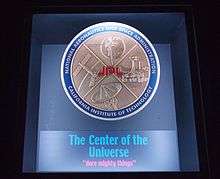Space Flight Operations Facility
|
Space Flight Operations Facility | |
|
Interior photograph of the control room at the Space Flight Operations Facility, with tables of monitors and workstations arrayed facing several large wall-mounted monitors. | |
   | |
| Location | Jet Propulsion Laboratory, Pasadena, California |
|---|---|
| Coordinates | 34°12′3.91″N 118°10′25.01″W / 34.2010861°N 118.1736139°WCoordinates: 34°12′3.91″N 118°10′25.01″W / 34.2010861°N 118.1736139°W |
| Area | 122,074 square feet[1] (11,340 m²) |
| Built | 1963 |
| Architect | NASA |
| NRHP Reference # | 85002814 |
| Significant dates | |
| Added to NRHP | October 03, 1985[2] |
| Designated NHL |
October 3, 1985 [3] |
Space Flight Operations Facility (SFOF) is a control room and related communications equipment areas at the Jet Propulsion Laboratory in Pasadena, California. NASA's Deep Space Network is operated from this facility. The SFOF has monitored and controlled all interplanetary and deep space exploration for NASA and other international space agencies since 1963. The facility also acted as a backup communications facility for Apollo missions.[1]
It was declared a National Historic Landmark in 1985 and is on the National Register of Historic Places.[1][3]
Public tours are available with advanced planning.[4]
History
In the early years, the operations control center of the Deep Space Network did not have a permanent facility. It was a makeshift setup with numerous desks and phones installed in a large room near the computers used to calculate orbits. In July 1961, NASA started the construction of the permanent facility, Space Flight Operations Facility (SFOF). The facility was completed in October 1963 dedicated on May 14, 1964. In the initial setup of the SFOF, there were 31 consoles, 100 closed-circuit television cameras, and more than 200 television displays to support Ranger 6 to Ranger 9 and Mariner 4.[5]
Current operations

As of 2012, there were 22 spacecraft monitored from this facility. Depending on the operations of the spacecraft, they were scheduled to be online for 1 to 10 hours at a time. The facility also process the signal from Voyager 1 at about 11 billion miles from Earth.[6] With the data feeding into the Space Flight Operations Facility from every NASA spacecraft beyond low earth orbit, whether they are rovers, orbiters, or deep-space probes, there is a plaque in the middle of the room to dedicate the facility as the center of the universe.[7]

See also
A list of other Deep Space Network facilities:
- Goldstone Deep Space Communications Complex
- Madrid Deep Space Communication Complex
- Canberra Deep Space Communication Complex
References
- 1 2 3 Harry A. Butowsky (May 15, 1984). "National Register of Historic Places Inventory-Nomination: Space Flight Operations Facility" (pdf). National Park Service. and Accompanying photos, exterior and interior, from 1976, 1981, and 1983 (32 KB)
- ↑ National Park Service (2007-01-23). "National Register Information System". National Register of Historic Places. National Park Service.
- 1 2 "Space Flight Operations Facility". National Historic Landmark summary listing. National Park Service. Retrieved 2008-02-13.
- ↑ Public Tours at JPL
- ↑ "Deep Space Network Operations Control Center at the Jet Propulsion Laboratory, Pasadena, California". Picture Album of the DEEP SPACE NETWORK. NASA/JPL. Retrieved 26 January 2014.
- ↑ Rose, Brent (9 February 2012). "This Is the Center of the Universe: NASA's Deep-Space Command Central". Gizmodo. Retrieved 27 January 2014.
- ↑ Edidin, Rachel (14 November 2013). "Inside a NASA Meetup, Where Science Fans Become Space Ambassadors". WIRED. Retrieved 27 January 2014.
External links
- Official Site
- Aviation: From Sand Dunes to Sonic Booms, a National Park Service Discover Our Shared Heritage Travel Itinerary
- Man in Space, a NHL Theme study


